
ALMA
State-of-the-art LLM-based translation models.
Stars: 308
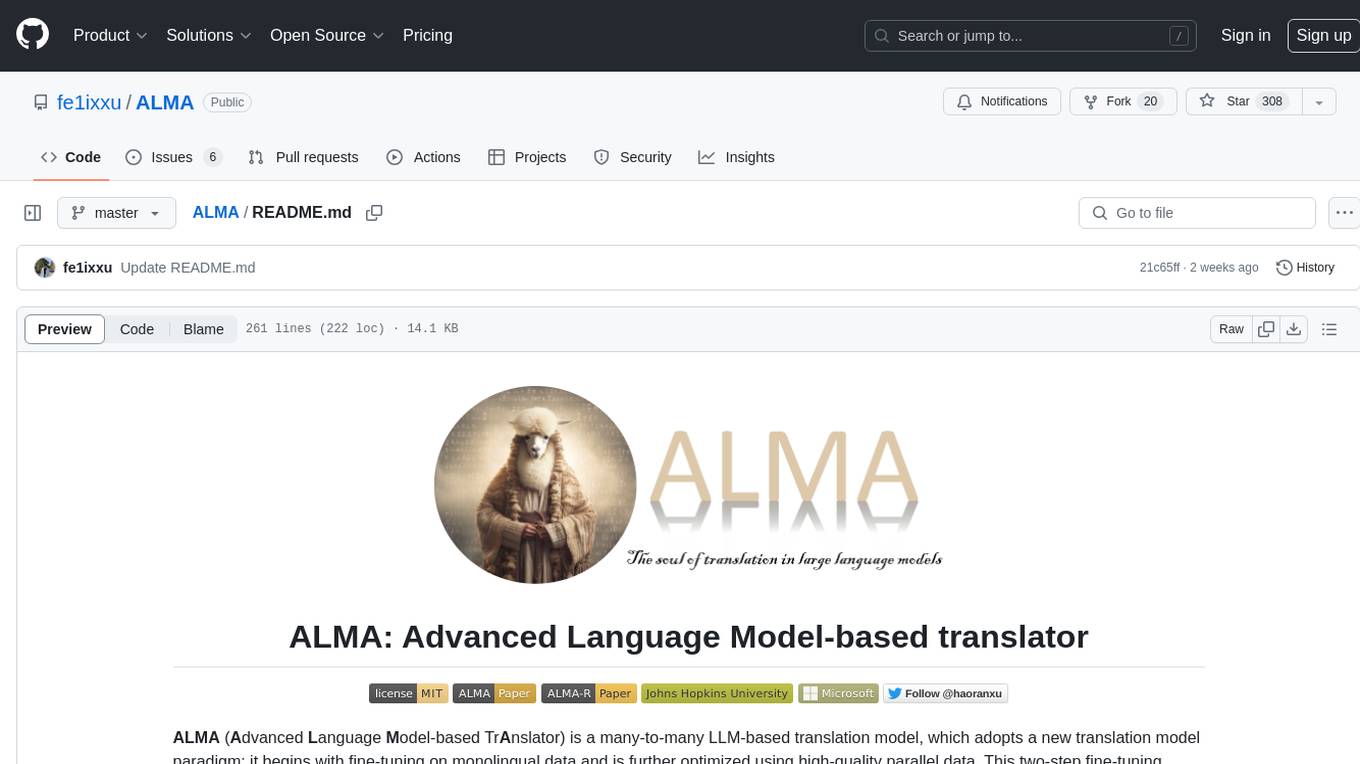
ALMA (Advanced Language Model-based Translator) is a many-to-many LLM-based translation model that utilizes a two-step fine-tuning process on monolingual and parallel data to achieve strong translation performance. ALMA-R builds upon ALMA models with LoRA fine-tuning and Contrastive Preference Optimization (CPO) for even better performance, surpassing GPT-4 and WMT winners. The repository provides ALMA and ALMA-R models, datasets, environment setup, evaluation scripts, training guides, and data information for users to leverage these models for translation tasks.
README:
ALMA (Advanced Language Model-based TrAnslator) is a many-to-many LLM-based translation model, which adopts a new translation model paradigm: it begins with fine-tuning on monolingual data and is further optimized using high-quality parallel data. This two-step fine-tuning process ensures strong translation performance.
ALMA-R (NEW!) builds upon ALMA models, with further LoRA fine-tuning with our proposed Contrastive Preference Optimization (CPO) as opposed to the Supervised Fine-tuning used in ALMA. CPO fine-tuning requires our triplet preference data for preference learning. ALMA-R now can matches or even exceeds GPT-4 or WMT winners!
The original ALMA repository can be found here.
⭐ May.1 CPO paper has been accepted at ICML 2024!
⭐ Mar.22 2024 CPO method now is merged at huggingface trl! See details here.
⭐ Jan.16 2024 ALMA-R is Released! Please check more details with our new paper: Contrastive Preference Optimization: Pushing the Boundaries of LLM Performance in Machine Translation.
⭐ Jan.16 2024 The ALMA paper: A Paradigm Shift in Machine Translation: Boosting Translation Performance of Large Language Models has been accepted at ICLR 2024! Check out more details here!
⭐ Supports ⭐
- AMD and Nvidia Cards
- Data Parallel Evaluation
- Also support LLaMA-1, LLaMA-2, OPT, Faclon, BLOOM, MPT
- LoRA Fine-tuning
- Monolingual data fine-tuning, parallel data fine-tuning
We release six translation models presented in the paper:
- ALMA-7B
- ALMA-7B-LoRA
- ALMA-7B-R (NEW!): Further LoRA fine-tuning upon ALMA-7B-LoRA with contrastive preference optimization.
- ALMA-13B
- ALMA-13B-LoRA
- ALMA-13B-R (NEW!): Further LoRA fine-tuning upon ALMA-13B-LoRA with contrastive preference optimization (BEST MODEL!).
We have also provided the WMT'22 and WMT'23 translation outputs from ALMA-13B-LoRA and ALMA-13B-R in the outputs directory. These outputs also includes our outputs of baselines and can be directly accessed and used for subsequent evaluations.
Model checkpoints are released at huggingface:
| Models | Base Model Link | LoRA Link |
|---|---|---|
| ALMA-7B | haoranxu/ALMA-7B | - |
| ALMA-7B-LoRA | haoranxu/ALMA-7B-Pretrain | haoranxu/ALMA-7B-Pretrain-LoRA |
| ALMA-7B-R (NEW!) | haoranxu/ALMA-7B-R (LoRA merged) | - |
| ALMA-13B | haoranxu/ALMA-13B | - |
| ALMA-13B-LoRA | haoranxu/ALMA-13B-Pretrain | haoranxu/ALMA-13B-Pretrain-LoRA |
| ALMA-13B-R (NEW!) | haoranxu/ALMA-13B-R (LoRA merged) | - |
Note that ALMA-7B-Pretrain and ALMA-13B-Pretrain are NOT translation models. They only experience stage 1 monolingual fine-tuning (20B tokens for the 7B model and 12B tokens for the 13B model), and should be utilized in conjunction with their LoRA models.
Datasets used by ALMA and ALMA-R are also released at huggingface now (NEW!)
| Datasets | Train / Validation | Test |
|---|---|---|
| Human-Written Parallel Data (ALMA) | train and validation | WMT'22 |
| Triplet Preference Data | train | WMT'22 and WMT'23 |
A quick start to use our best system (ALMA-13B-R) for translation. An example of translating "我爱机器翻译。" into English:
import torch
from transformers import AutoModelForCausalLM
from transformers import AutoTokenizer
# Load base model and LoRA weights
model = AutoModelForCausalLM.from_pretrained("haoranxu/ALMA-13B-R", torch_dtype=torch.float16, device_map="auto")
tokenizer = AutoTokenizer.from_pretrained("haoranxu/ALMA-13B-R", padding_side='left')
# Add the source sentence into the prompt template
prompt="Translate this from Chinese to English:\nChinese: 我爱机器翻译。\nEnglish:"
input_ids = tokenizer(prompt, return_tensors="pt", padding=True, max_length=40, truncation=True).input_ids.cuda()
# Translation
with torch.no_grad():
generated_ids = model.generate(input_ids=input_ids, num_beams=5, max_new_tokens=20, do_sample=True, temperature=0.6, top_p=0.9)
outputs = tokenizer.batch_decode(generated_ids, skip_special_tokens=True)
print(outputs)
The general translation prompt is:
Translate this from <source language name> into <target language name>:
<source language name>: <source language sentence>
<target language name>:
conda create -n alma-r python=3.11
conda activate alma-r
If you use Nvidia GPUs, install torch with cuda 11.8
pip3 install torch torchvision torchaudio --index-url https://download.pytorch.org/whl/cu118
If you use AMD GPUs, install torch with ROCm 5.6
pip3 install torch torchvision torchaudio --index-url https://download.pytorch.org/whl/rocm5.6
Then install other dependencies:
bash install_alma.sh
This is a quick start to evaluate our ALMA-13B-R model. To produce translation outputs for WMT'22 in both en→cs and cs→en directions (If you want to evaluate WMT'23 instead, simply pass --override_test_data_path haoranxu/WMT23-Test. Please look at evals/alma_13b_r_wmt23.sh as an example), run the following command:
accelerate launch --config_file configs/deepspeed_eval_config_bf16.yaml \
run_llmmt.py \
--model_name_or_path haoranxu/ALMA-13B-R \
--do_predict \
--low_cpu_mem_usage \
--language_pairs en-cs,cs-en \
--mmt_data_path ./human_written_data/ \
--per_device_eval_batch_size 1 \
--output_dir ./your_output_dir/ \
--predict_with_generate \
--max_new_tokens 256 \
--max_source_length 256 \
--bf16 \
--seed 42 \
--num_beams 5 \
--overwrite_cache \
--overwrite_output_dir
The generated outputs will be saved in the your_output_dir. The translation file for the en→cs direction is named test-en-cs, and the file for the cs→en direction is test-cs-en.
We have prepared a bash file for the user to easily run the evaluation:
bash evals/alma_13b_r.sh ${your_output_dir} ${test_pairs}
The variable ${test_pairs} denotes the translation directions you wish to evaluate. It supports testing multiple directions at once. For example, you can use de-en,en-de,en-cs,cs-en. Once the bash script completes its execution, both the BLEU scores and COMET results will be automatically displayed.
Note that this will perform data-parallel evaluation supported by deepspeed: that is, placing a single full copy of your model onto each available GPU and splitting batches across GPUs to evaluate on K GPUs K times faster than on one. For those with limited GPU memory, we offer an alternative method. The user can pass --multi_gpu_one_model to run the process by distributing a single model across multiple GPUs. Please see evaluation examples in evals/alma_13b_r.sh or evals/*no_parallel files.
To append examples in the prompt, you need to pass the --few_shot_eval_path flag and specify the location of their shot files. As a demonstration, you can execute the following command:
bash evals/llama-2-13b-5-shot.sh ${OUTPUT_DIR} ${test_pairs}
Here we show how to
- (NEW!) contrastive Preference Optmization Upon ALMA Models (ALMA→ALMA-R).
- fine-tune LLaMA-2-7B on monolingual OSCAR data (stage 1)
- fine-tune human-written parallel data fine-tuning once stage 1 is completed, including full-weight and LoRA fine-tuning (stage 2)
To run the CPO fine-tuning with our triplet preference data, run the following command:
bash runs/cpo_ft.sh ${your_output_dir}
To execute the OSCAR monolingual fine-tuning, use the following command:
bash runs/mono_ft.sh ${your_output_dir}
Once the monolingual data fine-tuning is complete, proceed to the parallel data fine-tuning using the full-weight approach. Execute the following command:
bash runs/parallel_ft.sh ${your_output_dir} $training_pairs$
where training_pairs is the translation directions you considered. The default is all 10 directions: de-en,cs-en,is-en,zh-en,ru-en,en-de,en-cs,en-is,en-zh,en-ru.
In Stage 2, there's also an option to employ LoRA for fine-tuning on the parallel data. To do so, execute the following command:
bash runs/parallel_ft_lora.sh ${your_output_dir} $training_pairs$
Human-written training dataset, along with the WMT'22 test dataset, can be found in the human_written_data directory. Within this directory, there are five subfolders, each representing one of the five language pairs. Each of these subfolders contains the training, development, and test sets for its respective language pair.
-deen
-train.de-en.json
-valid.de-en.json
-test.de-en.json
-test.en-de.json
....
-csen
-isen
-ruen
.....
The data format in json files must be:
{
"translation":
{
"src(de)": "source sentence",
"tgt(en)": "target sentence",
}
}
Within this directory, there are two additional subfolders specifically designed for few-shot in-context learning:
-
Filtered-5-shot: This contains the "filtered shots" as referenced in the paper. -
HW-5-shot: This contains the "randomly extracted human-written data" mentioned in the paper.
Currently, ALMA supports 10 directions: English↔German, Englishs↔Czech, Englishs↔Icelandic, Englishs↔Chinese, Englishs↔Russian. However, it may surprise us in other directions :)
Our 7B and 13B models are trained on 20B and 12B tokens, respectively. However, as indicated in the paper, fine-tuning 1B tokens should boost the performance substantially. The steps required to fine-tune 1 billion tokens also vary based on your batch size. In our case, the batch size is calculated as follows: 16 GPUs * 4 (batch size per GPU) * 4 (gradient accumulation steps) = 256. With a sequence length of 512, we need approximately 8,000 steps to train on 1 billion tokens, calculated as 10^9 / (256*512) ≈8000 steps. However, you may choose to fine-tune more steps to get better performance.
Please find the reasons for interleave probability selection for stage 1 in Appendix D.1 in the paper!
Please find more details for ALMA models in our paper or the summary of the paper.
@misc{xu2023paradigm,
title={A Paradigm Shift in Machine Translation: Boosting Translation Performance of Large Language Models},
author={Haoran Xu and Young Jin Kim and Amr Sharaf and Hany Hassan Awadalla},
year={2023},
eprint={2309.11674},
archivePrefix={arXiv},
primaryClass={cs.CL}
}
Please also find more detailed information for the ALMA-R model with Contrastive Preference Optimization in the paper.
@misc{xu2024contrastive,
title={Contrastive Preference Optimization: Pushing the Boundaries of LLM Performance in Machine Translation},
author={Haoran Xu and Amr Sharaf and Yunmo Chen and Weiting Tan and Lingfeng Shen and Benjamin Van Durme and Kenton Murray and Young Jin Kim},
year={2024},
eprint={2401.08417},
archivePrefix={arXiv},
primaryClass={cs.CL}
}
For Tasks:
Click tags to check more tools for each tasksFor Jobs:
Alternative AI tools for ALMA
Similar Open Source Tools

ALMA
ALMA (Advanced Language Model-based Translator) is a many-to-many LLM-based translation model that utilizes a two-step fine-tuning process on monolingual and parallel data to achieve strong translation performance. ALMA-R builds upon ALMA models with LoRA fine-tuning and Contrastive Preference Optimization (CPO) for even better performance, surpassing GPT-4 and WMT winners. The repository provides ALMA and ALMA-R models, datasets, environment setup, evaluation scripts, training guides, and data information for users to leverage these models for translation tasks.
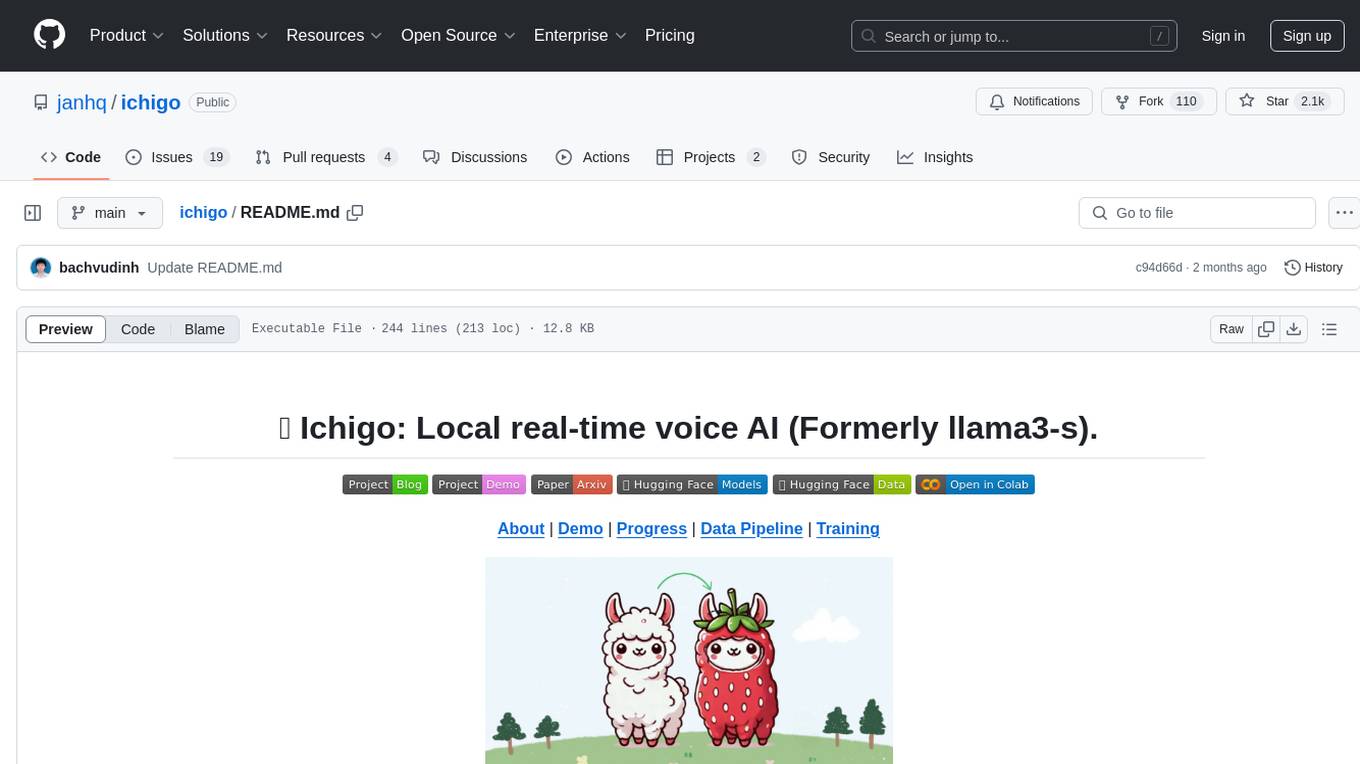
ichigo
Ichigo is a local real-time voice AI tool that uses an early fusion technique to extend a text-based LLM to have native 'listening' ability. It is an open research experiment with improved multiturn capabilities and the ability to refuse processing inaudible queries. The tool is designed for open data, open weight, on-device Siri-like functionality, inspired by Meta's Chameleon paper. Ichigo offers a web UI demo and Gradio web UI for users to interact with the tool. It has achieved enhanced MMLU scores, stronger context handling, advanced noise management, and improved multi-turn capabilities for a robust user experience.
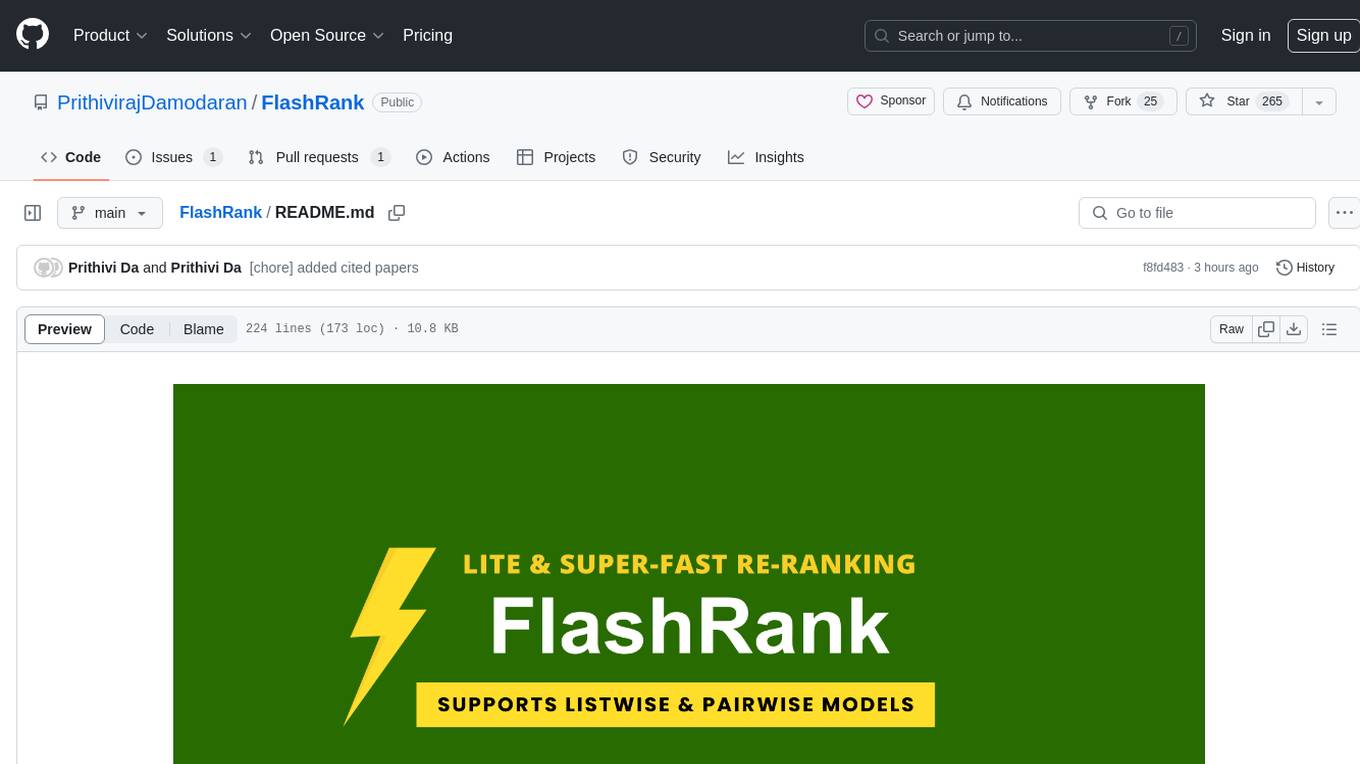
FlashRank
FlashRank is an ultra-lite and super-fast Python library designed to add re-ranking capabilities to existing search and retrieval pipelines. It is based on state-of-the-art Language Models (LLMs) and cross-encoders, offering support for pairwise/pointwise rerankers and listwise LLM-based rerankers. The library boasts the tiniest reranking model in the world (~4MB) and runs on CPU without the need for Torch or Transformers. FlashRank is cost-conscious, with a focus on low cost per invocation and smaller package size for efficient serverless deployments. It supports various models like ms-marco-TinyBERT, ms-marco-MiniLM, rank-T5-flan, ms-marco-MultiBERT, and more, with plans for future model additions. The tool is ideal for enhancing search precision and speed in scenarios where lightweight models with competitive performance are preferred.
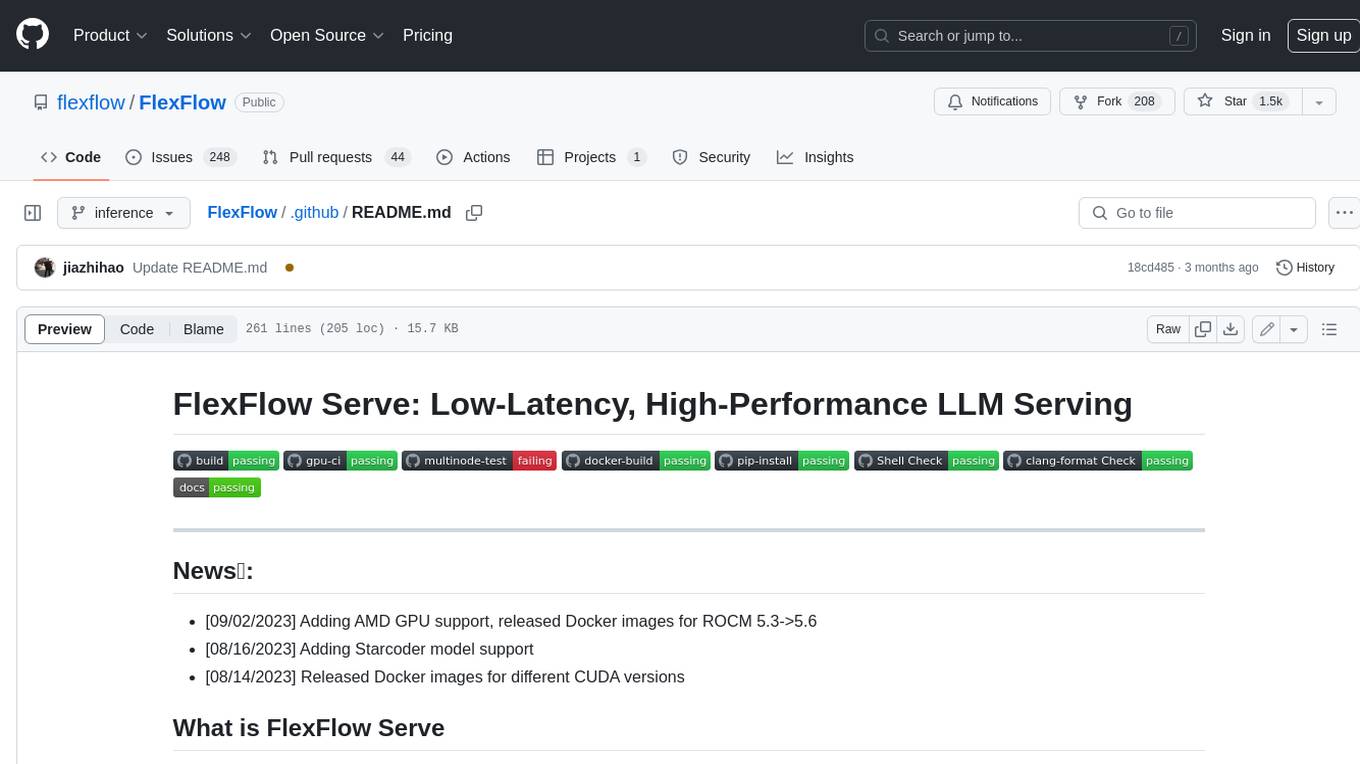
FlexFlow
FlexFlow Serve is an open-source compiler and distributed system for **low latency**, **high performance** LLM serving. FlexFlow Serve outperforms existing systems by 1.3-2.0x for single-node, multi-GPU inference and by 1.4-2.4x for multi-node, multi-GPU inference.
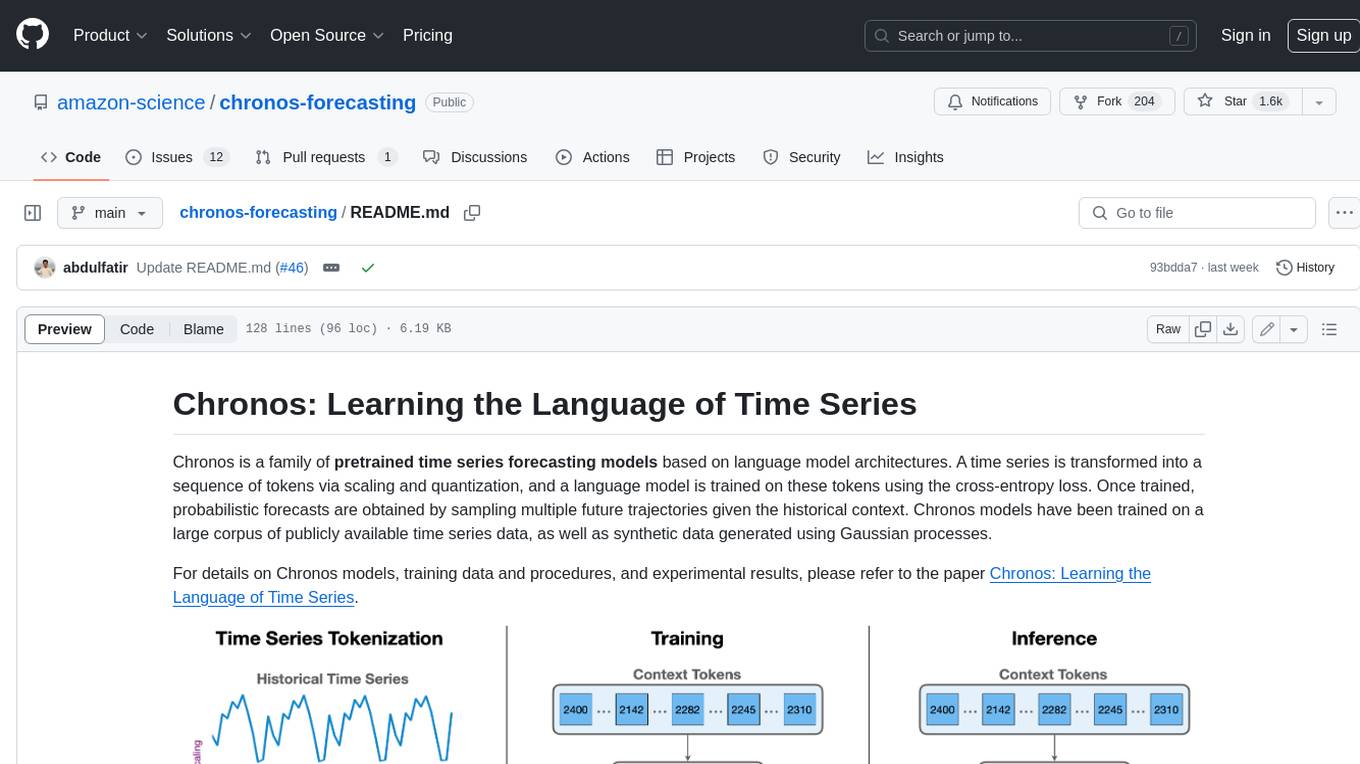
chronos-forecasting
Chronos is a family of pretrained time series forecasting models based on language model architectures. A time series is transformed into a sequence of tokens via scaling and quantization, and a language model is trained on these tokens using the cross-entropy loss. Once trained, probabilistic forecasts are obtained by sampling multiple future trajectories given the historical context. Chronos models have been trained on a large corpus of publicly available time series data, as well as synthetic data generated using Gaussian processes.
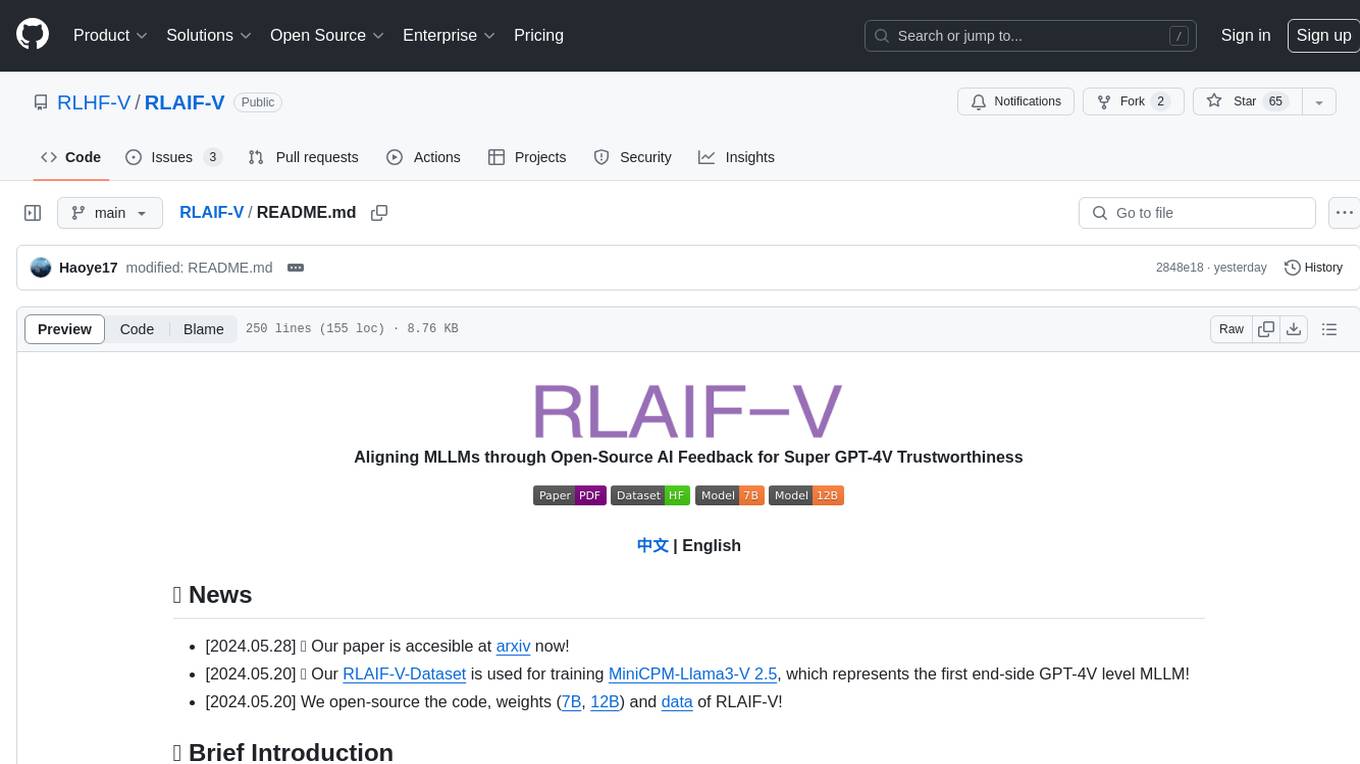
RLAIF-V
RLAIF-V is a novel framework that aligns MLLMs in a fully open-source paradigm for super GPT-4V trustworthiness. It maximally exploits open-source feedback from high-quality feedback data and online feedback learning algorithm. Notable features include achieving super GPT-4V trustworthiness in both generative and discriminative tasks, using high-quality generalizable feedback data to reduce hallucination of different MLLMs, and exhibiting better learning efficiency and higher performance through iterative alignment.
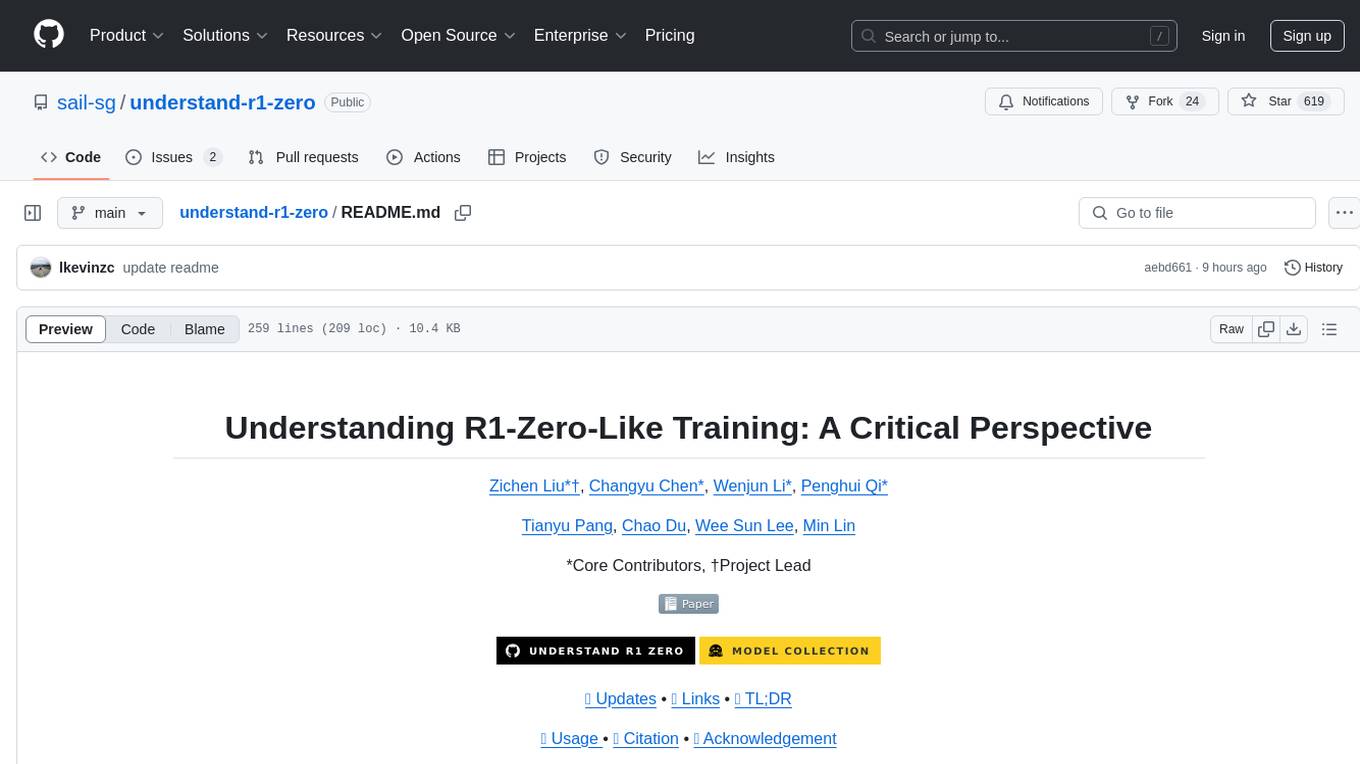
understand-r1-zero
The 'understand-r1-zero' repository focuses on understanding R1-Zero-like training from a critical perspective. It provides insights into base models and reinforcement learning components, highlighting findings and proposing solutions for biased optimization. The repository offers a minimalist recipe for R1-Zero training, detailing the RL-tuning process and achieving state-of-the-art performance with minimal compute resources. It includes codebase, models, and paper related to R1-Zero training implemented with the Oat framework, emphasizing research-friendly and efficient LLM RL techniques.
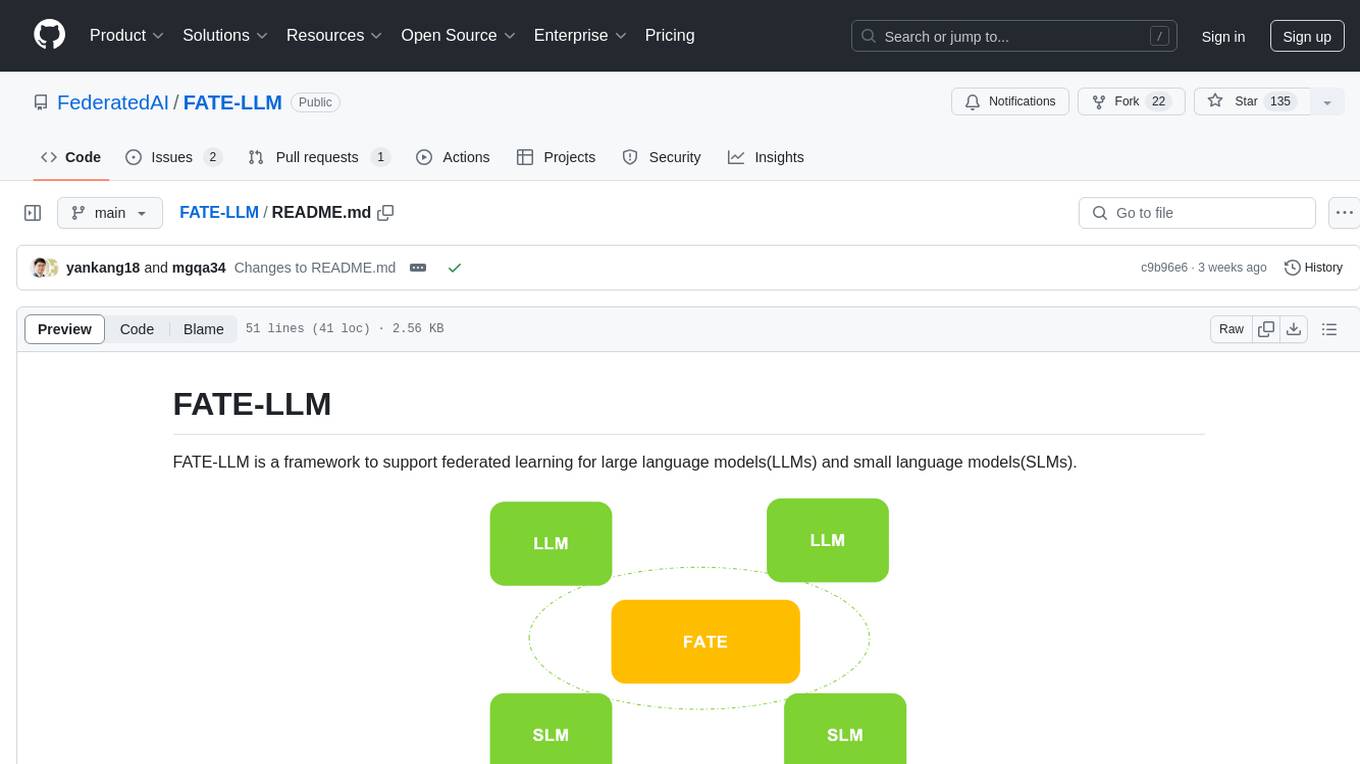
FATE-LLM
FATE-LLM is a framework supporting federated learning for large and small language models. It promotes training efficiency of federated LLMs using Parameter-Efficient methods, protects the IP of LLMs using FedIPR, and ensures data privacy during training and inference through privacy-preserving mechanisms.
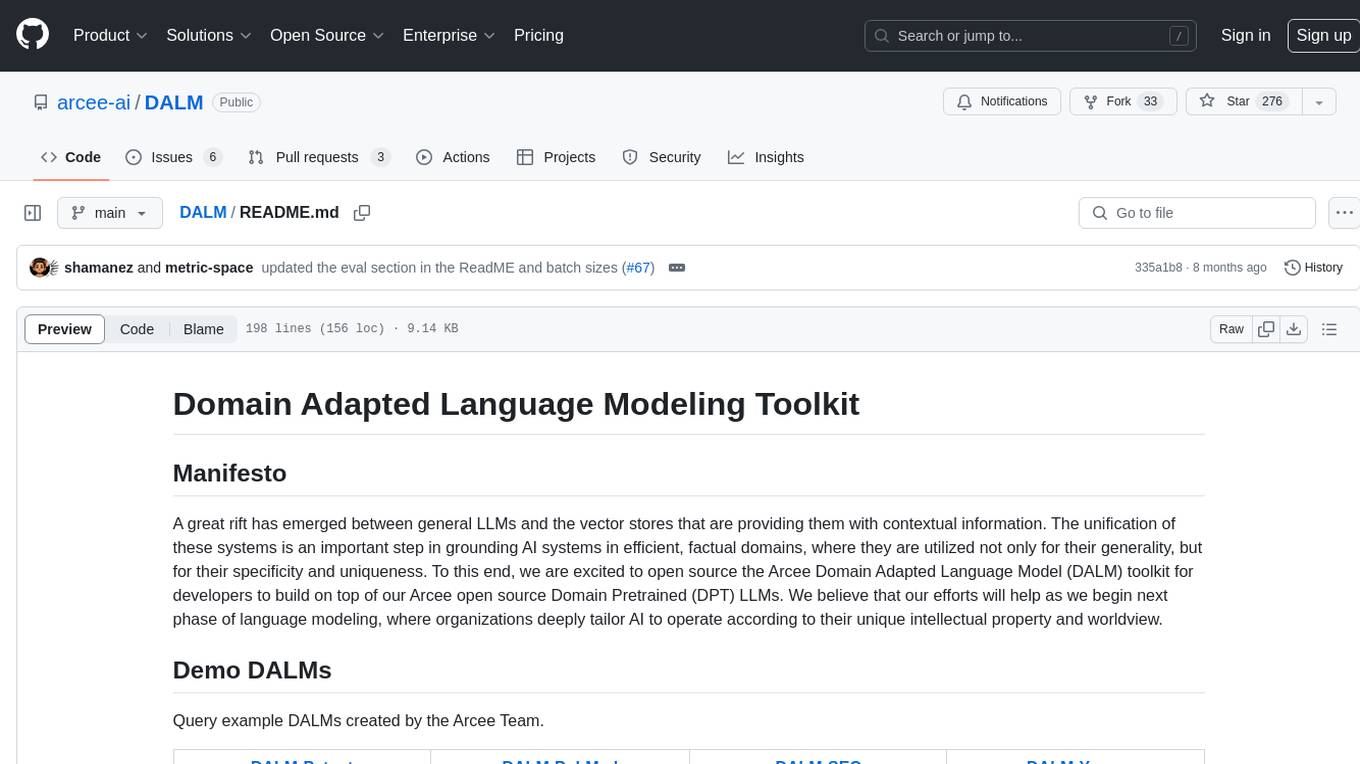
DALM
The DALM (Domain Adapted Language Modeling) toolkit is designed to unify general LLMs with vector stores to ground AI systems in efficient, factual domains. It provides developers with tools to build on top of Arcee's open source Domain Pretrained LLMs, enabling organizations to deeply tailor AI according to their unique intellectual property and worldview. The toolkit contains code for fine-tuning a fully differential Retrieval Augmented Generation (RAG-end2end) architecture, incorporating in-batch negative concept alongside RAG's marginalization for efficiency. It includes training scripts for both retriever and generator models, evaluation scripts, data processing codes, and synthetic data generation code.
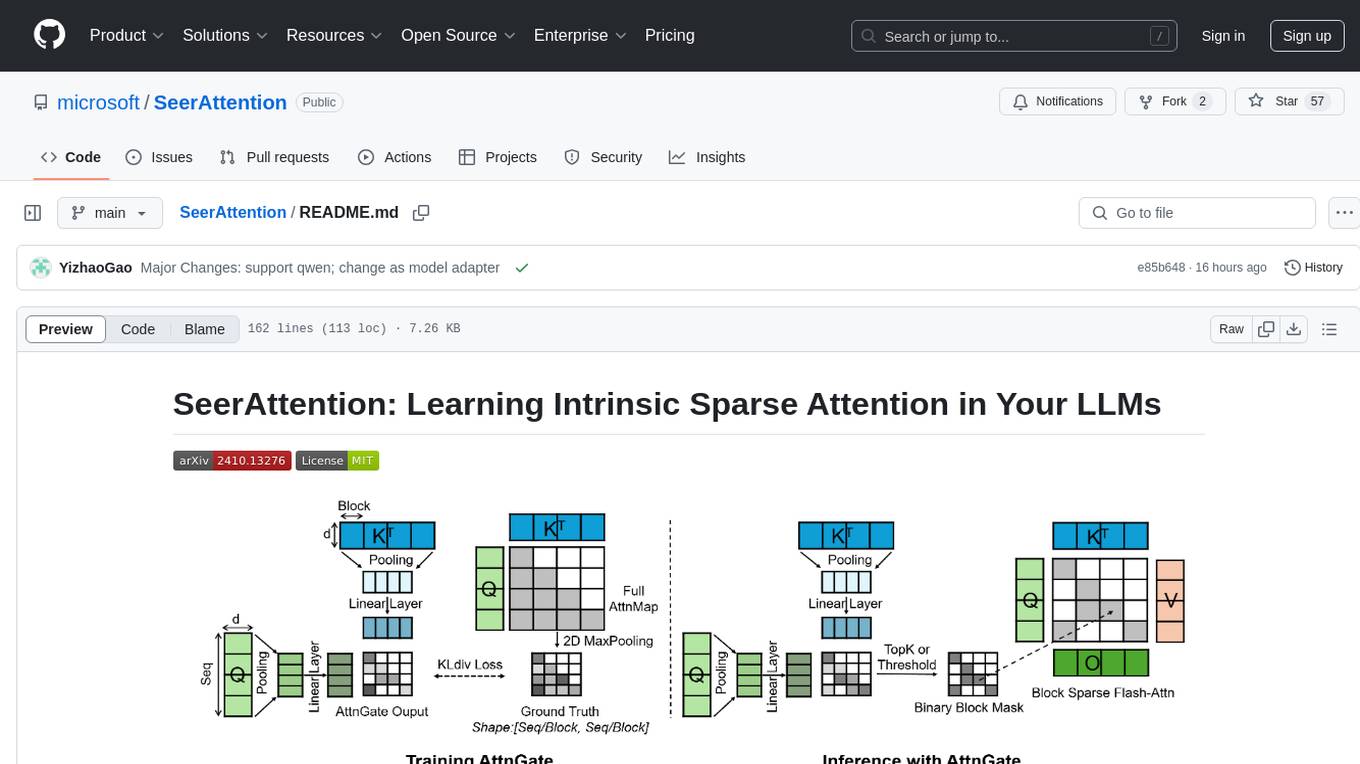
SeerAttention
SeerAttention is a novel trainable sparse attention mechanism that learns intrinsic sparsity patterns directly from LLMs through self-distillation at post-training time. It achieves faster inference while maintaining accuracy for long-context prefilling. The tool offers features such as trainable sparse attention, block-level sparsity, self-distillation, efficient kernel, and easy integration with existing transformer architectures. Users can quickly start using SeerAttention for inference with AttnGate Adapter and training attention gates with self-distillation. The tool provides efficient evaluation methods and encourages contributions from the community.
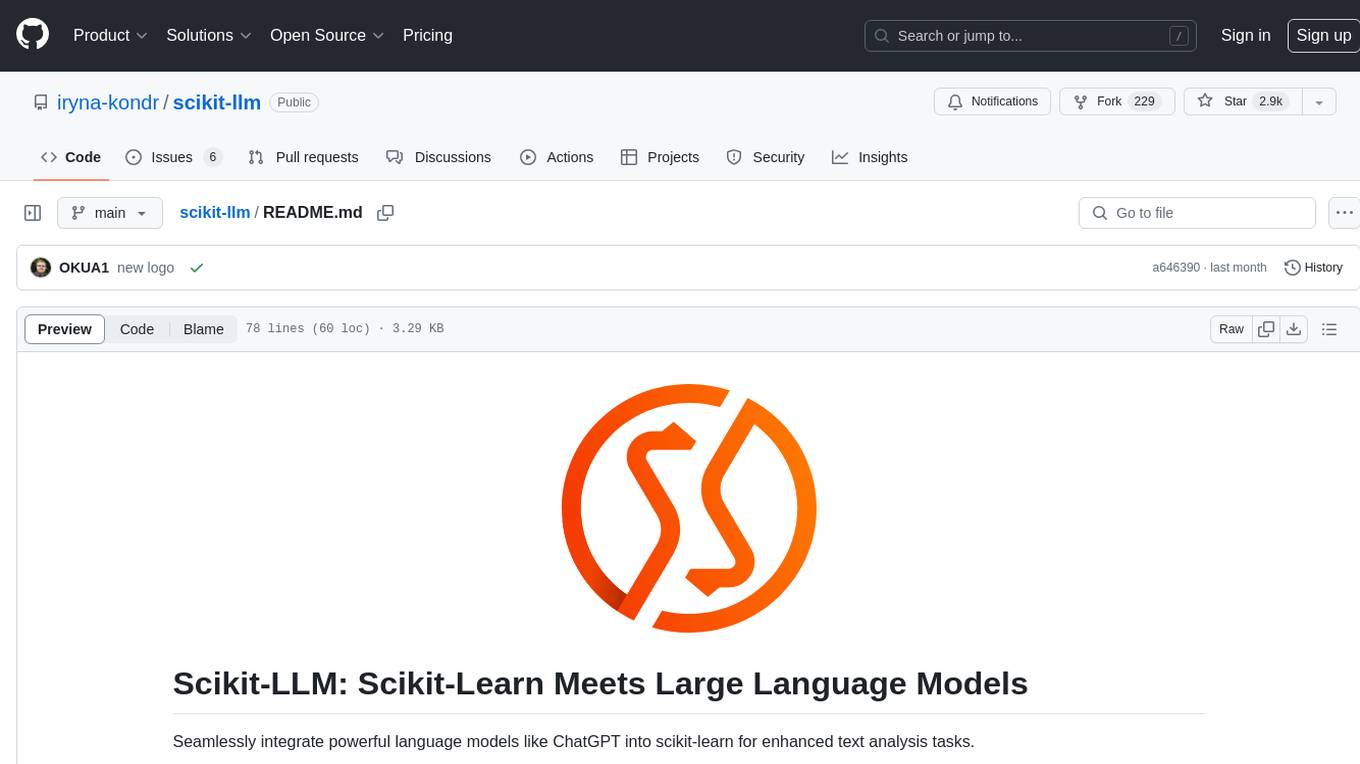
scikit-llm
Scikit-LLM is a tool that seamlessly integrates powerful language models like ChatGPT into scikit-learn for enhanced text analysis tasks. It allows users to leverage large language models for various text analysis applications within the familiar scikit-learn framework. The tool simplifies the process of incorporating advanced language processing capabilities into machine learning pipelines, enabling users to benefit from the latest advancements in natural language processing.
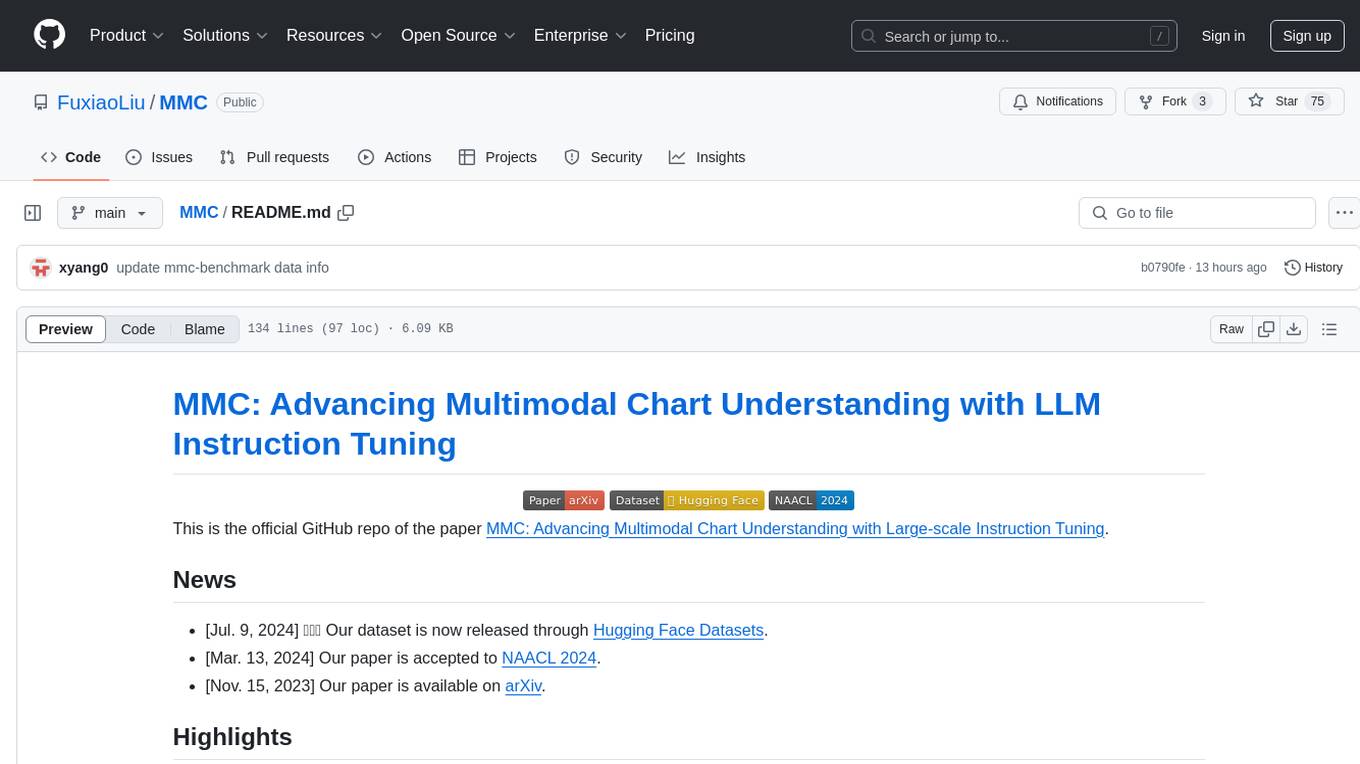
MMC
This repository, MMC, focuses on advancing multimodal chart understanding through large-scale instruction tuning. It introduces a dataset supporting various tasks and chart types, a benchmark for evaluating reasoning capabilities over charts, and an assistant achieving state-of-the-art performance on chart QA benchmarks. The repository provides data for chart-text alignment, benchmarking, and instruction tuning, along with existing datasets used in experiments. Additionally, it offers a Gradio demo for the MMCA model.
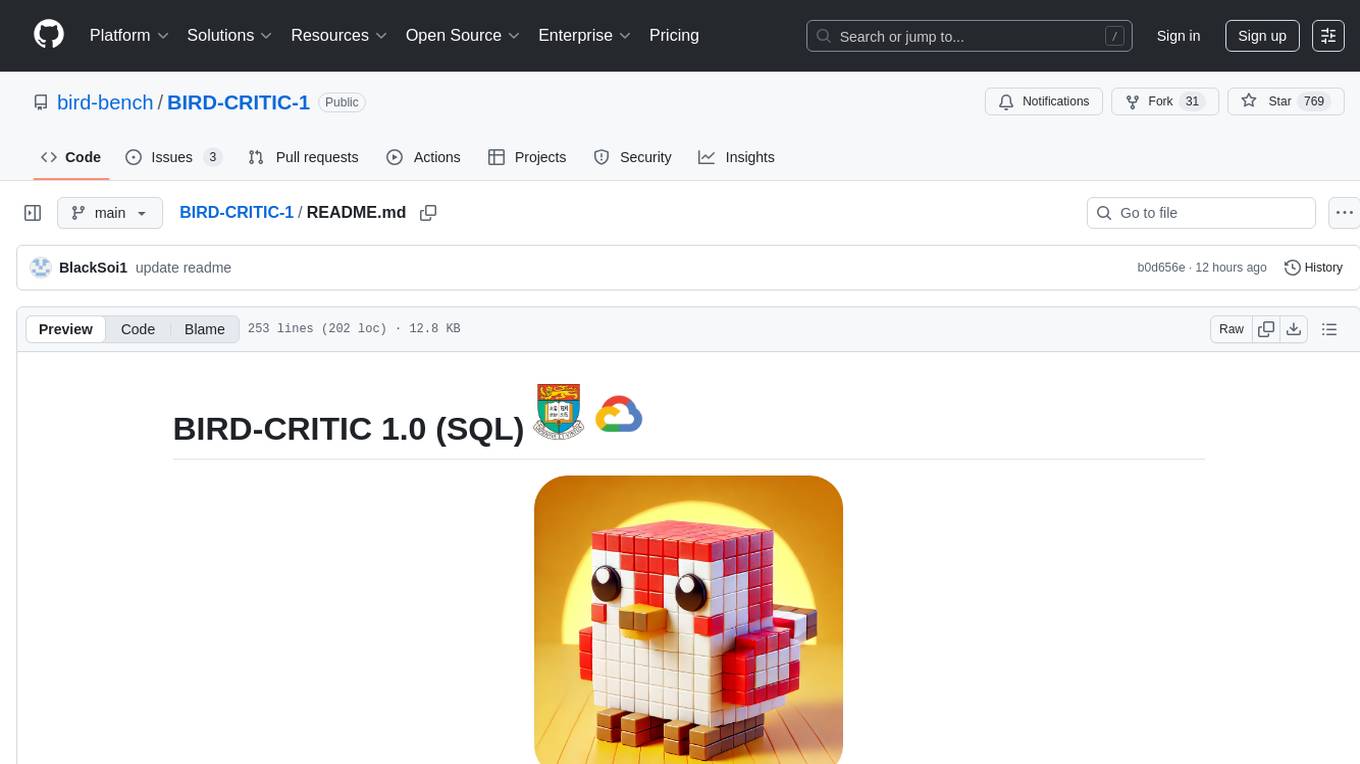
BIRD-CRITIC-1
BIRD-CRITIC 1.0 is a SQL benchmark designed to evaluate the capability of large language models (LLMs) in diagnosing and solving user issues within real-world database environments. It comprises 600 tasks for development and 200 held-out out-of-distribution tests across 4 prominent open-source SQL dialects. The benchmark expands beyond simple SELECT queries to cover a wider range of SQL operations, reflecting actual application scenarios. An optimized execution-based evaluation environment is included for rigorous and efficient validation.
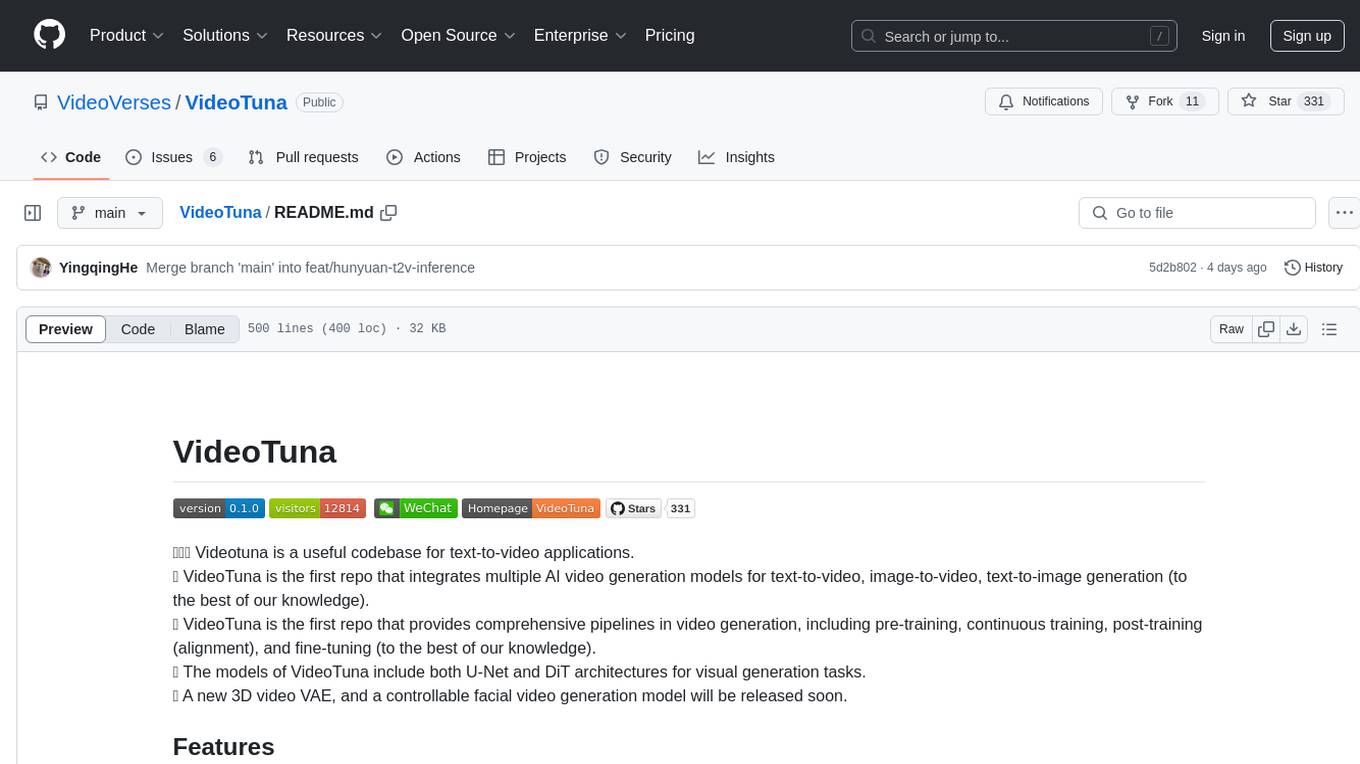
VideoTuna
VideoTuna is a codebase for text-to-video applications that integrates multiple AI video generation models for text-to-video, image-to-video, and text-to-image generation. It provides comprehensive pipelines in video generation, including pre-training, continuous training, post-training, and fine-tuning. The models in VideoTuna include U-Net and DiT architectures for visual generation tasks, with upcoming releases of a new 3D video VAE and a controllable facial video generation model.
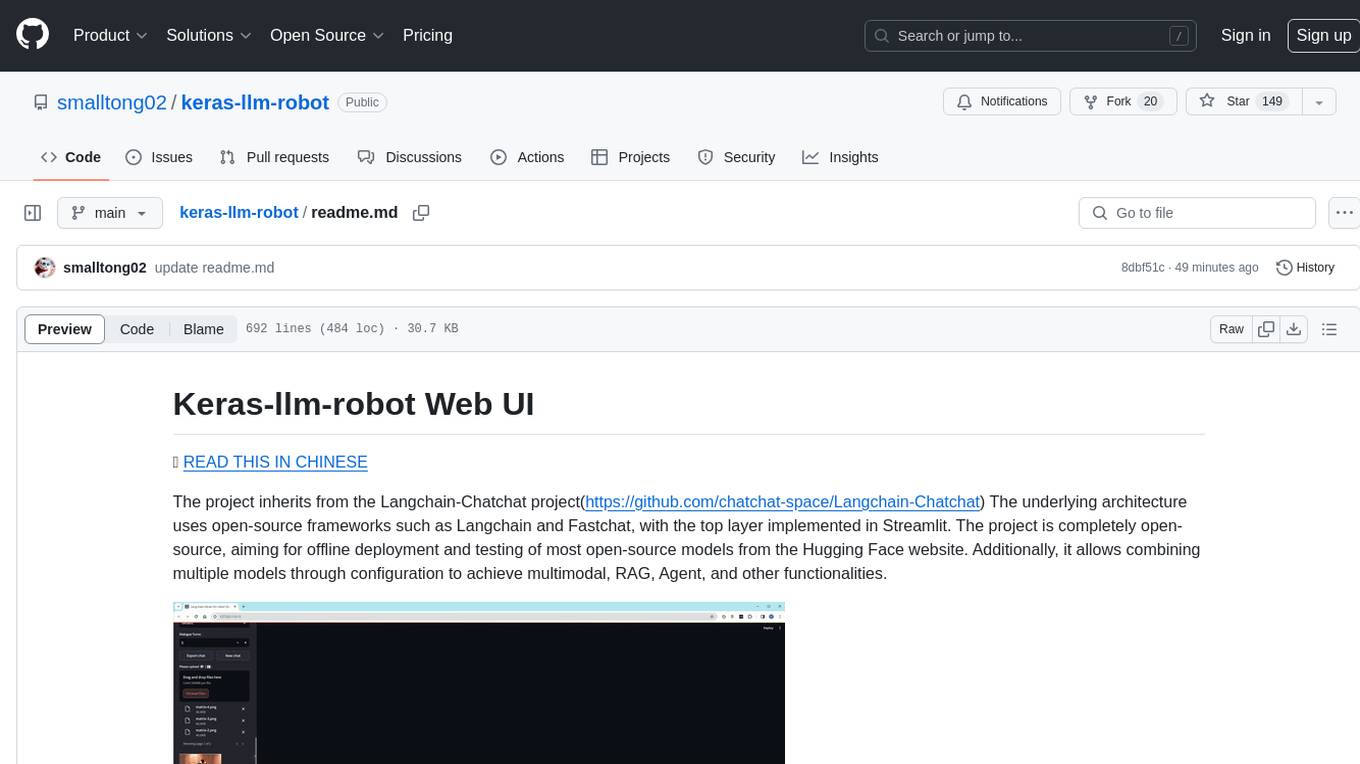
keras-llm-robot
The Keras-llm-robot Web UI project is an open-source tool designed for offline deployment and testing of various open-source models from the Hugging Face website. It allows users to combine multiple models through configuration to achieve functionalities like multimodal, RAG, Agent, and more. The project consists of three main interfaces: chat interface for language models, configuration interface for loading models, and tools & agent interface for auxiliary models. Users can interact with the language model through text, voice, and image inputs, and the tool supports features like model loading, quantization, fine-tuning, role-playing, code interpretation, speech recognition, image recognition, network search engine, and function calling.
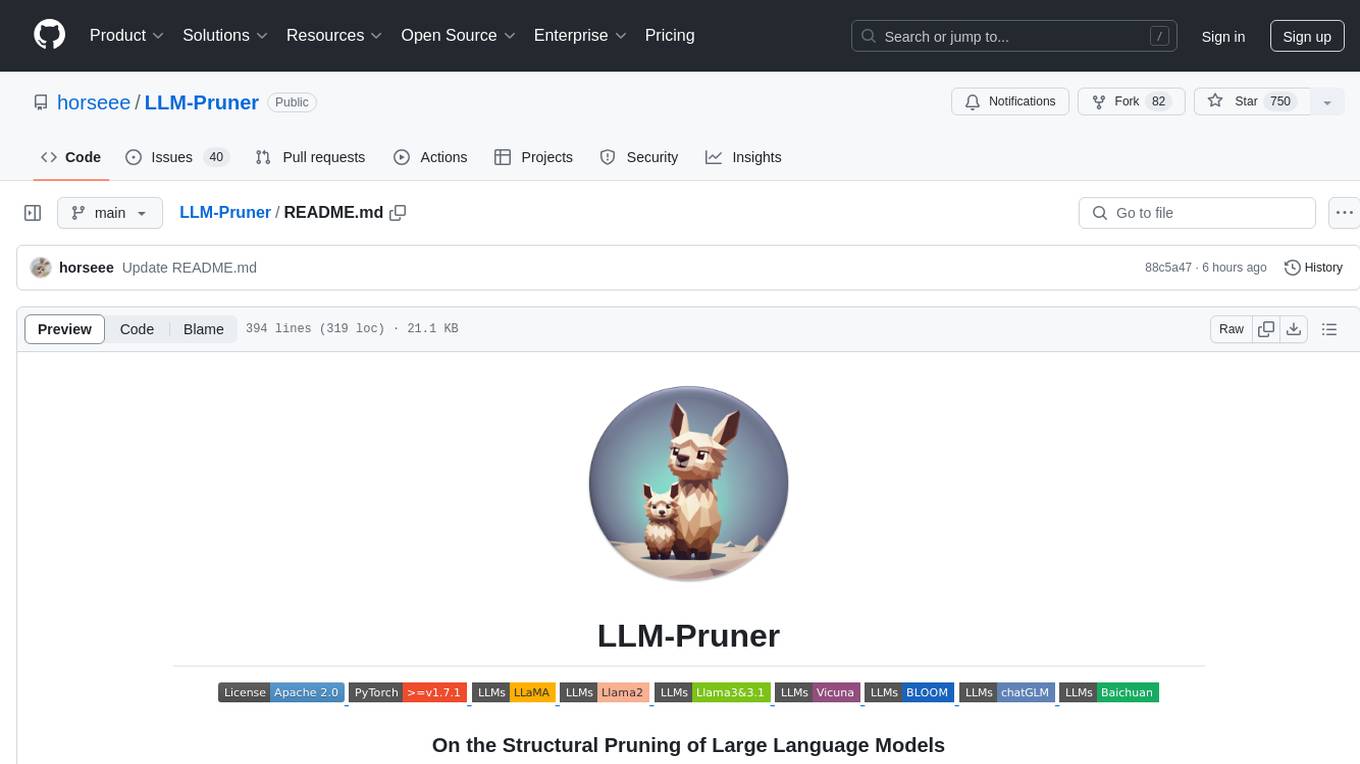
LLM-Pruner
LLM-Pruner is a tool for structural pruning of large language models, allowing task-agnostic compression while retaining multi-task solving ability. It supports automatic structural pruning of various LLMs with minimal human effort. The tool is efficient, requiring only 3 minutes for pruning and 3 hours for post-training. Supported LLMs include Llama-3.1, Llama-3, Llama-2, LLaMA, BLOOM, Vicuna, and Baichuan. Updates include support for new LLMs like GQA and BLOOM, as well as fine-tuning results achieving high accuracy. The tool provides step-by-step instructions for pruning, post-training, and evaluation, along with a Gradio interface for text generation. Limitations include issues with generating repetitive or nonsensical tokens in compressed models and manual operations for certain models.
For similar tasks

ALMA
ALMA (Advanced Language Model-based Translator) is a many-to-many LLM-based translation model that utilizes a two-step fine-tuning process on monolingual and parallel data to achieve strong translation performance. ALMA-R builds upon ALMA models with LoRA fine-tuning and Contrastive Preference Optimization (CPO) for even better performance, surpassing GPT-4 and WMT winners. The repository provides ALMA and ALMA-R models, datasets, environment setup, evaluation scripts, training guides, and data information for users to leverage these models for translation tasks.
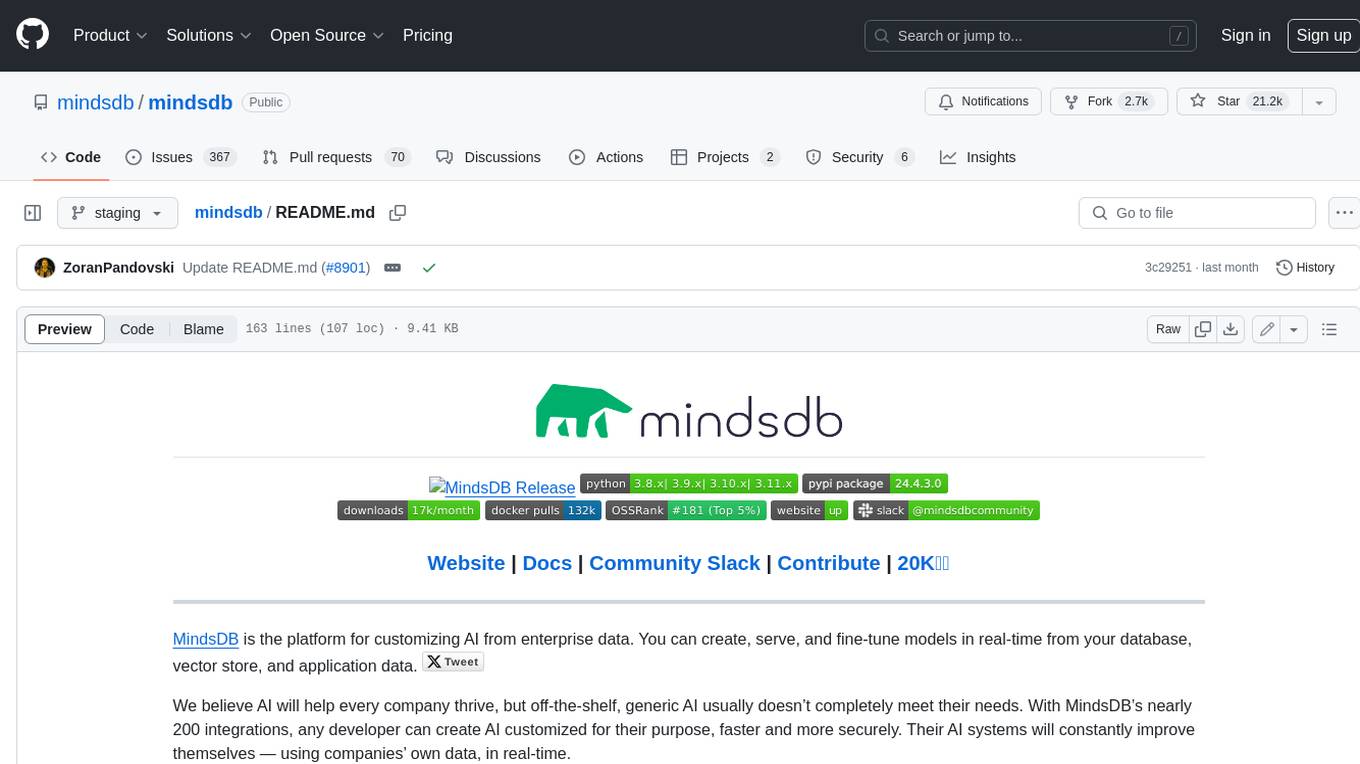
mindsdb
MindsDB is a platform for customizing AI from enterprise data. You can create, serve, and fine-tune models in real-time from your database, vector store, and application data. MindsDB "enhances" SQL syntax with AI capabilities to make it accessible for developers worldwide. With MindsDB’s nearly 200 integrations, any developer can create AI customized for their purpose, faster and more securely. Their AI systems will constantly improve themselves — using companies’ own data, in real-time.
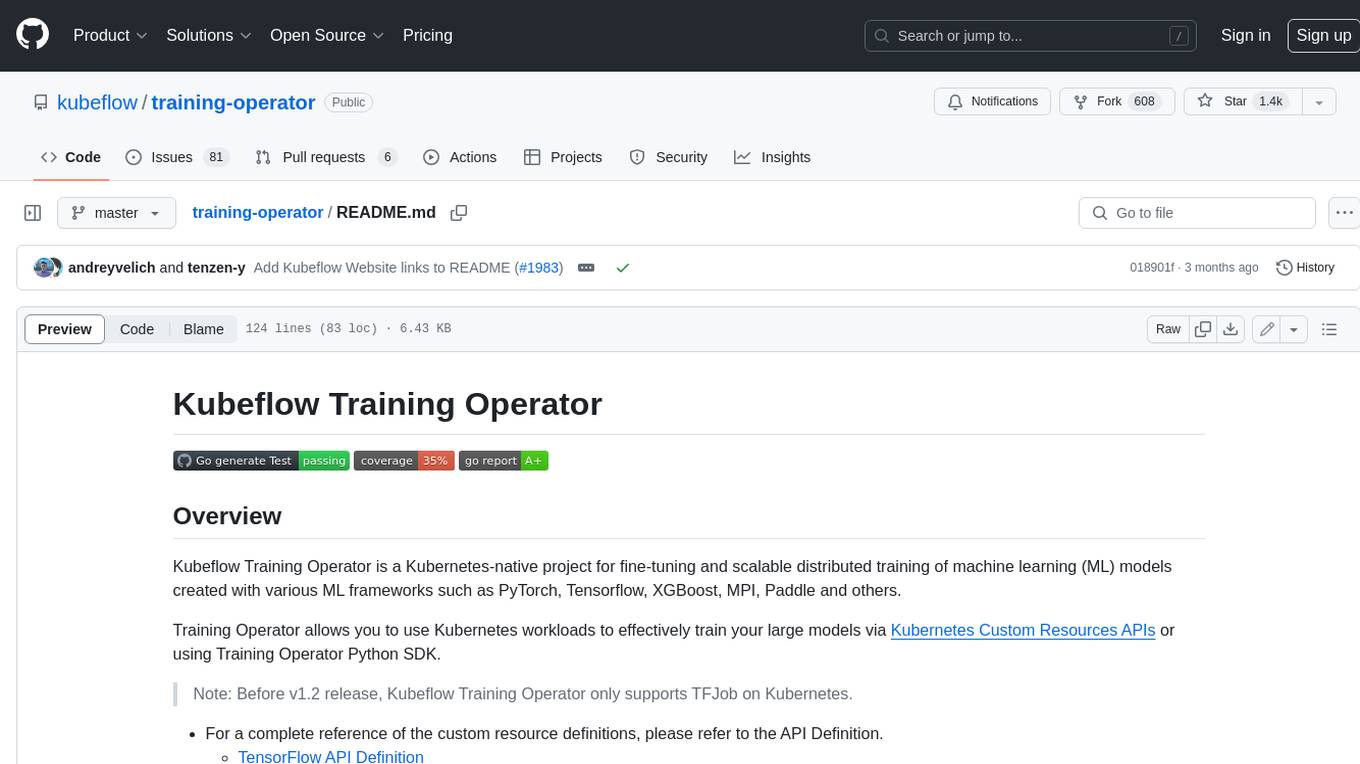
training-operator
Kubeflow Training Operator is a Kubernetes-native project for fine-tuning and scalable distributed training of machine learning (ML) models created with various ML frameworks such as PyTorch, Tensorflow, XGBoost, MPI, Paddle and others. Training Operator allows you to use Kubernetes workloads to effectively train your large models via Kubernetes Custom Resources APIs or using Training Operator Python SDK. > Note: Before v1.2 release, Kubeflow Training Operator only supports TFJob on Kubernetes. * For a complete reference of the custom resource definitions, please refer to the API Definition. * TensorFlow API Definition * PyTorch API Definition * Apache MXNet API Definition * XGBoost API Definition * MPI API Definition * PaddlePaddle API Definition * For details of all-in-one operator design, please refer to the All-in-one Kubeflow Training Operator * For details on its observability, please refer to the monitoring design doc.
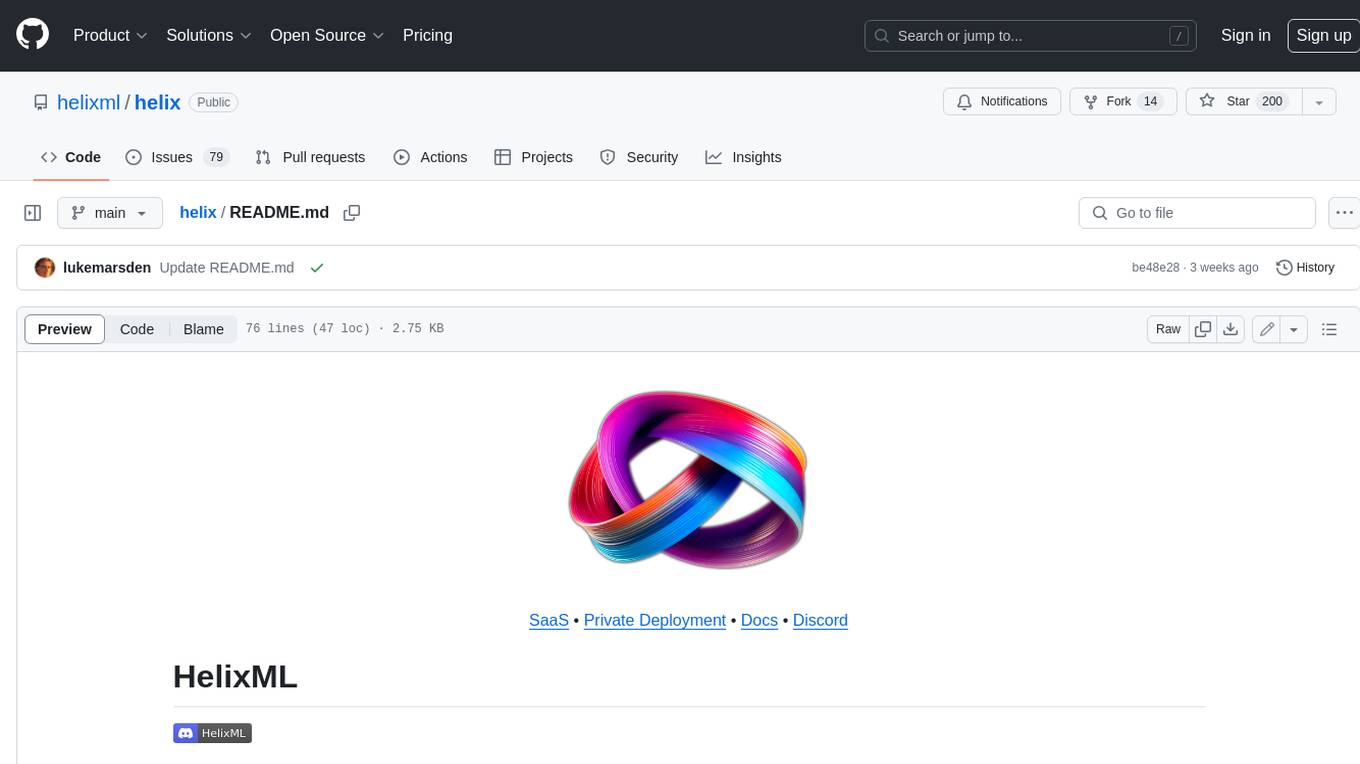
helix
HelixML is a private GenAI platform that allows users to deploy the best of open AI in their own data center or VPC while retaining complete data security and control. It includes support for fine-tuning models with drag-and-drop functionality. HelixML brings the best of open source AI to businesses in an ergonomic and scalable way, optimizing the tradeoff between GPU memory and latency.
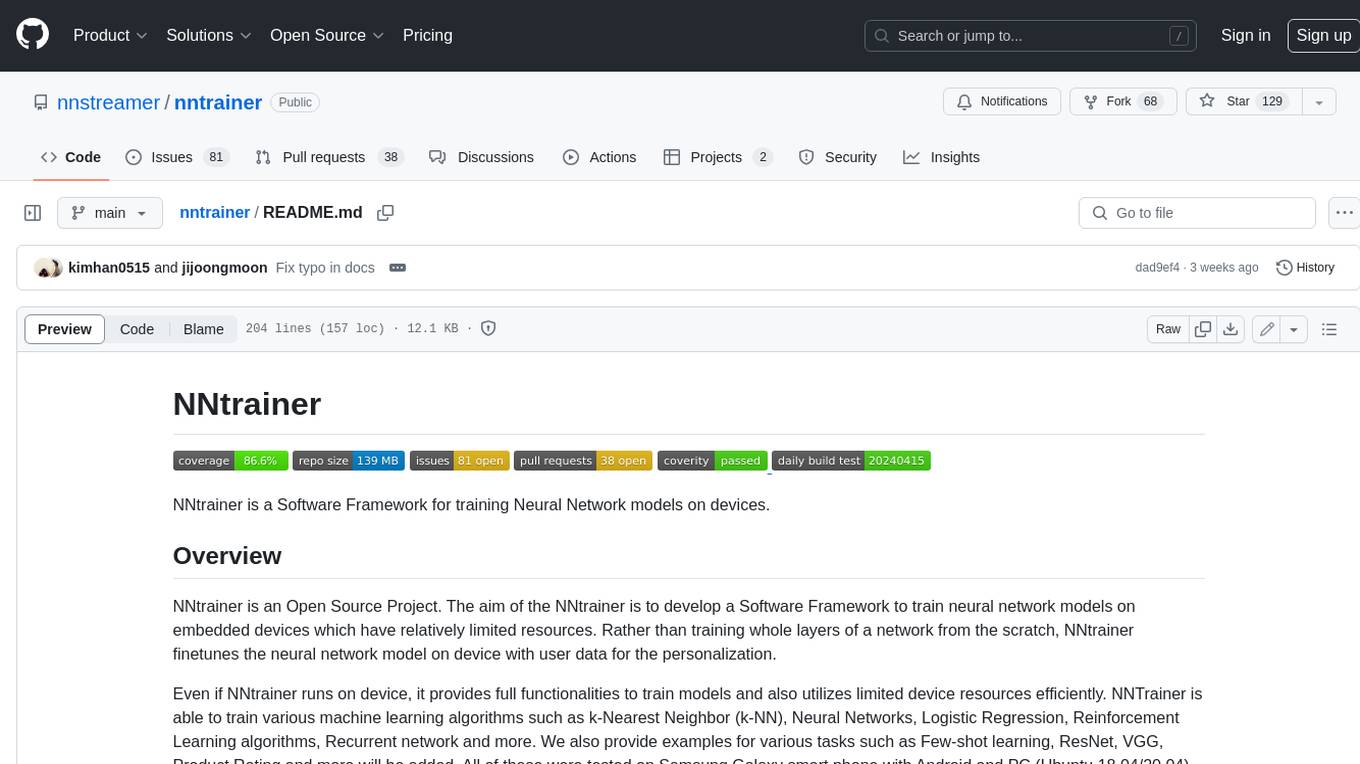
nntrainer
NNtrainer is a software framework for training neural network models on devices with limited resources. It enables on-device fine-tuning of neural networks using user data for personalization. NNtrainer supports various machine learning algorithms and provides examples for tasks such as few-shot learning, ResNet, VGG, and product rating. It is optimized for embedded devices and utilizes CBLAS and CUBLAS for accelerated calculations. NNtrainer is open source and released under the Apache License version 2.0.
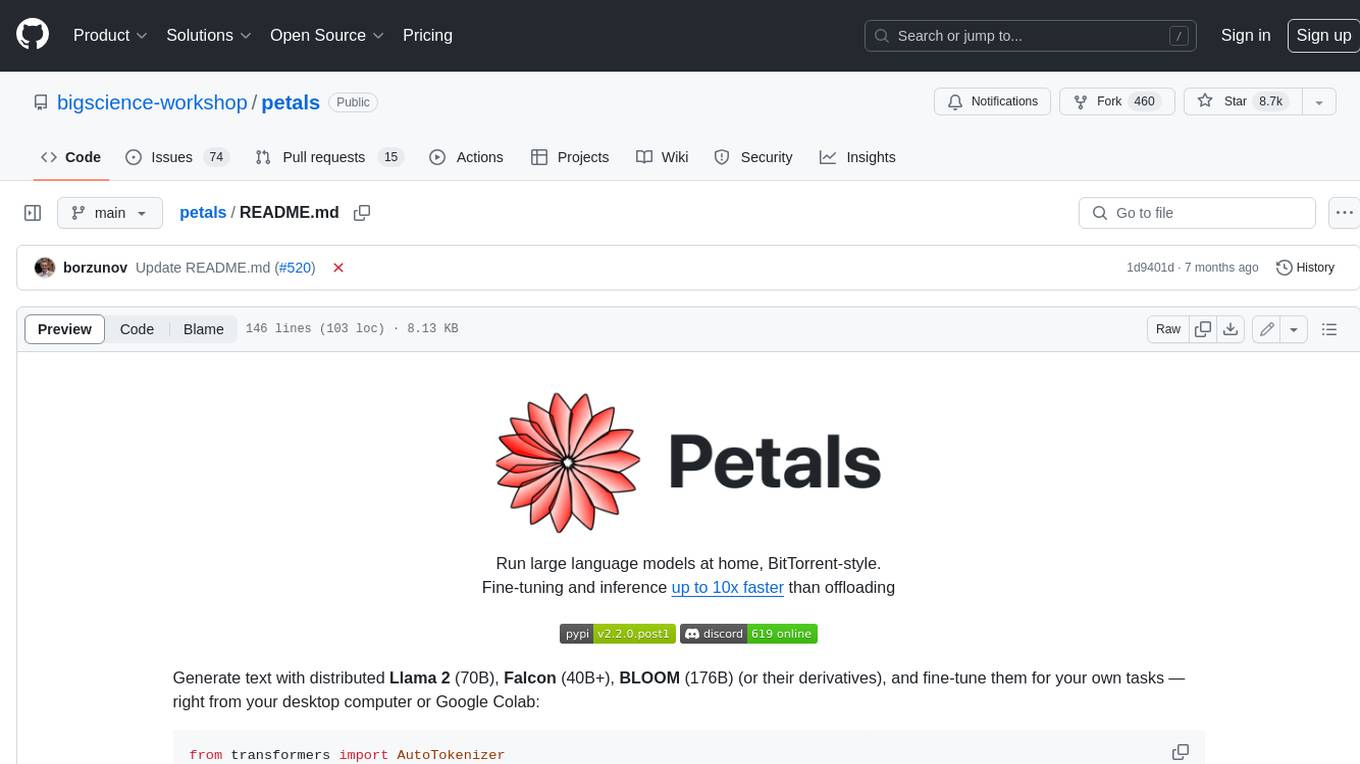
petals
Petals is a tool that allows users to run large language models at home in a BitTorrent-style manner. It enables fine-tuning and inference up to 10x faster than offloading. Users can generate text with distributed models like Llama 2, Falcon, and BLOOM, and fine-tune them for specific tasks directly from their desktop computer or Google Colab. Petals is a community-run system that relies on people sharing their GPUs to increase its capacity and offer a distributed network for hosting model layers.
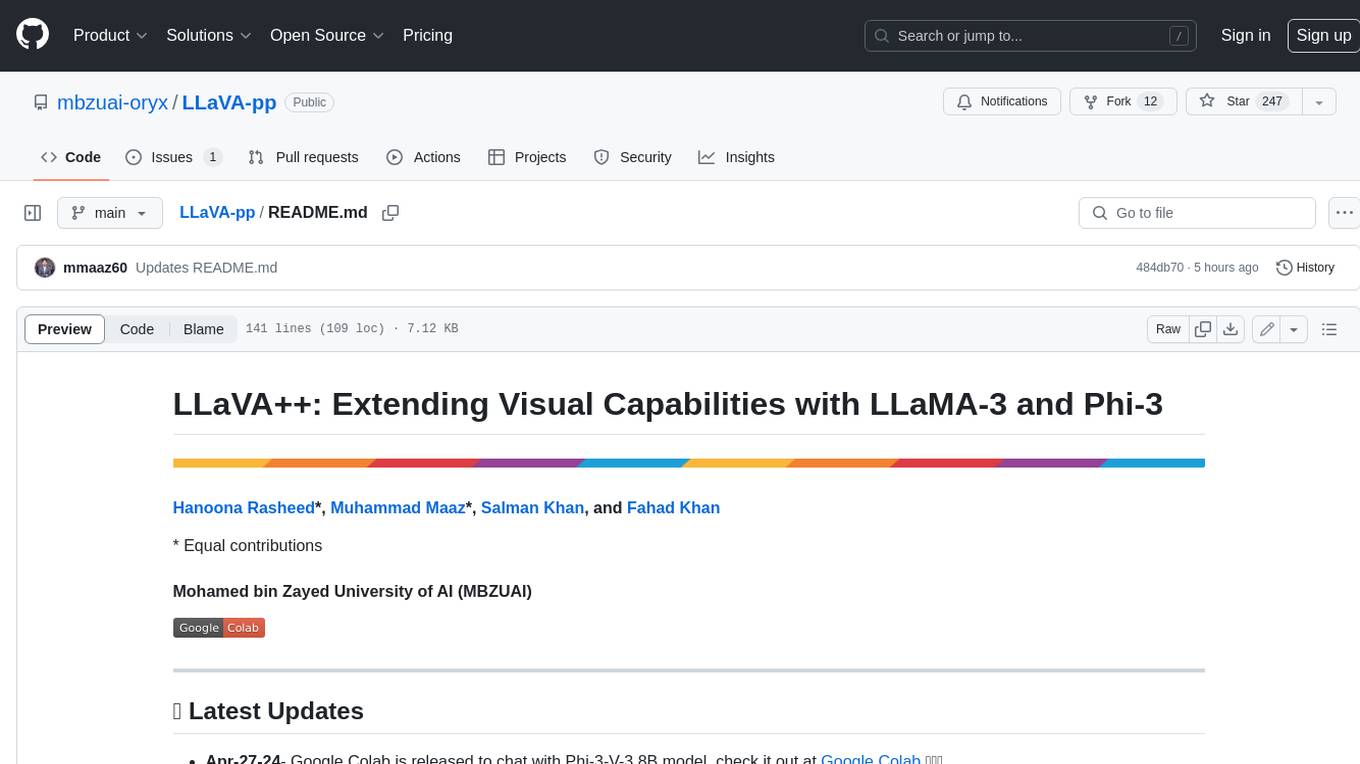
LLaVA-pp
This repository, LLaVA++, extends the visual capabilities of the LLaVA 1.5 model by incorporating the latest LLMs, Phi-3 Mini Instruct 3.8B, and LLaMA-3 Instruct 8B. It provides various models for instruction-following LMMS and academic-task-oriented datasets, along with training scripts for Phi-3-V and LLaMA-3-V. The repository also includes installation instructions and acknowledgments to related open-source contributions.
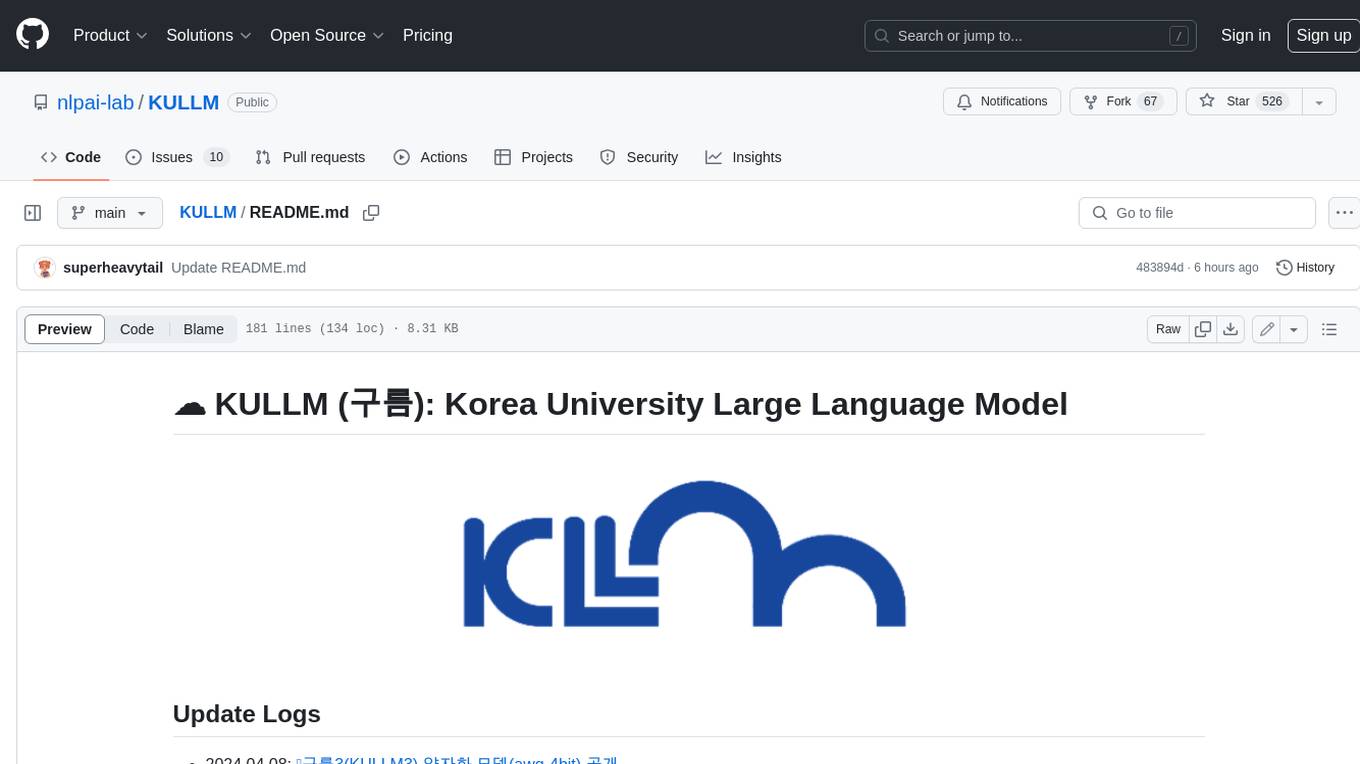
KULLM
KULLM (구름) is a Korean Large Language Model developed by Korea University NLP & AI Lab and HIAI Research Institute. It is based on the upstage/SOLAR-10.7B-v1.0 model and has been fine-tuned for instruction. The model has been trained on 8×A100 GPUs and is capable of generating responses in Korean language. KULLM exhibits hallucination and repetition phenomena due to its decoding strategy. Users should be cautious as the model may produce inaccurate or harmful results. Performance may vary in benchmarks without a fixed system prompt.
For similar jobs

weave
Weave is a toolkit for developing Generative AI applications, built by Weights & Biases. With Weave, you can log and debug language model inputs, outputs, and traces; build rigorous, apples-to-apples evaluations for language model use cases; and organize all the information generated across the LLM workflow, from experimentation to evaluations to production. Weave aims to bring rigor, best-practices, and composability to the inherently experimental process of developing Generative AI software, without introducing cognitive overhead.

agentcloud
AgentCloud is an open-source platform that enables companies to build and deploy private LLM chat apps, empowering teams to securely interact with their data. It comprises three main components: Agent Backend, Webapp, and Vector Proxy. To run this project locally, clone the repository, install Docker, and start the services. The project is licensed under the GNU Affero General Public License, version 3 only. Contributions and feedback are welcome from the community.

oss-fuzz-gen
This framework generates fuzz targets for real-world `C`/`C++` projects with various Large Language Models (LLM) and benchmarks them via the `OSS-Fuzz` platform. It manages to successfully leverage LLMs to generate valid fuzz targets (which generate non-zero coverage increase) for 160 C/C++ projects. The maximum line coverage increase is 29% from the existing human-written targets.

LLMStack
LLMStack is a no-code platform for building generative AI agents, workflows, and chatbots. It allows users to connect their own data, internal tools, and GPT-powered models without any coding experience. LLMStack can be deployed to the cloud or on-premise and can be accessed via HTTP API or triggered from Slack or Discord.

VisionCraft
The VisionCraft API is a free API for using over 100 different AI models. From images to sound.

kaito
Kaito is an operator that automates the AI/ML inference model deployment in a Kubernetes cluster. It manages large model files using container images, avoids tuning deployment parameters to fit GPU hardware by providing preset configurations, auto-provisions GPU nodes based on model requirements, and hosts large model images in the public Microsoft Container Registry (MCR) if the license allows. Using Kaito, the workflow of onboarding large AI inference models in Kubernetes is largely simplified.

PyRIT
PyRIT is an open access automation framework designed to empower security professionals and ML engineers to red team foundation models and their applications. It automates AI Red Teaming tasks to allow operators to focus on more complicated and time-consuming tasks and can also identify security harms such as misuse (e.g., malware generation, jailbreaking), and privacy harms (e.g., identity theft). The goal is to allow researchers to have a baseline of how well their model and entire inference pipeline is doing against different harm categories and to be able to compare that baseline to future iterations of their model. This allows them to have empirical data on how well their model is doing today, and detect any degradation of performance based on future improvements.

Azure-Analytics-and-AI-Engagement
The Azure-Analytics-and-AI-Engagement repository provides packaged Industry Scenario DREAM Demos with ARM templates (Containing a demo web application, Power BI reports, Synapse resources, AML Notebooks etc.) that can be deployed in a customer’s subscription using the CAPE tool within a matter of few hours. Partners can also deploy DREAM Demos in their own subscriptions using DPoC.







